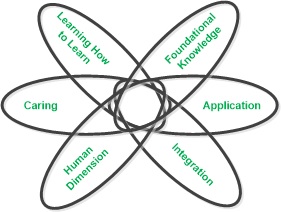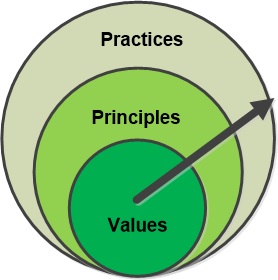Whether you are a high school teacher, a college professor or professional training instructor you probably always look for ways to increase value you bring to a classroom and some of the questions you might be asking yourself are: “how to enrich students’ in-class experience?”, “how to ensure information retention by students?” and “how t make in-class learning more applicable to real life?”. This summary focuses on the following three aspects of teaching: dynamic teaching, teaching focus, feedback loop between teachers and students.
Every instructor must have a set of Learning Objective, based on which, training content is built. Meeting these objectives deems a training successful. But there are different schools of thought about educational learning:
Bloom’s Taxonomy classification model for educational learning (created by Dr. B. Bloom in 1956) implies that human thinking goes through six evolutionary (maturity) stages that, if were mapped to Japanese martial art concept of SHU-HA-RI that describes the stages of learning to mastery, would approximately group-by as follows: SHU (Remembering, Understanding, Applying) = “traditional wisdom”, HA (Analyzing, Evaluating) = “breaking with tradition”, RI (Creating) = “transcendence”. With this thinking approach, to proceed to a next level of maturity, a person must pass through preceding levels. This type of learning is hierarchical/sequential and uni-dimensional.
An alternative, and more dynamic, taxonomy of leaning has been proposed by L. Dee Fink of University of Oklahoma, in his The Power of Course Design to Increase Student Engagement and Learning. With this new thinking approach, instead of looking at learning as a hierarchical and sequential journey, we treat it as multi-dimensional process, where each dimension is independent and can interact/overlap with other dimensions, in a Venn-like style. The following are learning dimensions (categories) proposed by Fink: Foundational knowledge, Application, Integration, Human dimension, Caring, Learning How to Learn.

All categories are independent of one another and within each category, students can advance to different degree of maturity. Within each of the categories, there could be a critical minimum of learning objectives that must be met by all students – this is something that is decided by an instructor. Beyond this critical minimum, learning remains dynamic and conditional and is based on an instructor’s assessment of in-class dynamics (may vary from audience to audience).
Truth be told, in comprehensive multi-session courses (e.g. college or university), where a professor has enough ‘runway’ to build-up her audience for more advanced topics, there is a relatively low risk of short-cutting/by-passing basics, in favor of practical learning.
On the other hand, in short, time-boxed professional training (e.g. a few hours or a few days) there is a higher chance that foundation learning could be shortened by an instructor, in favor of topics that appear (only superficially) to have a more direct real-life relevance. In short training engagements, due to time constrains and a desire to jam as much information as possible in a session, we see these sacrifices primarily made because:
- Instructors are pressured to deliver “maximum practical value for a buck” by their sponsors
- Students attend against their will, with superficial goals to “rent” an instructor’s immediate solutions, instead of learning how to find their own
- Certain “hot” topics that challenge current organizational values and norms are omitted, to avoid inflaming discussions
A good example of teaching focus loss would be an agile training by an agile consultant, where a class immediately focuses on their day-to-day problems and “best” practices (e.g. metrics, tools, techniques and workflows), instead of learning agile values first (e.g. human interactions, relationships, mindset, collaboration, compensation etc.). [More information about typical challenges with agile training]
By short-cutting to immediate practical implementations and offering ready-to-use “unwrap & install” solutions, trainers significantly reduce students’ chances of retaining learning, developing autonomy and capability of creating and owning their own decisions (as opposed to “renting” from instructor).

Instead of working from outside-in (as per the diagram above), instructors should strive leading students from inside-out, by ensuring that students understand core values first, then build new principles upon values, and only then proceed to developing their own practices.
In 2014, in his “Don’t give me Feedback”, Tobias Mayer described how any type of direct feedback, whether positive or negative, is a judgment made by the giver on the receiver. Being a judgment call, feedback is always subjective and is anchored to a giver’s personal and self-centered views and ambitions. Here is an example from a typical agile training:
A positive feedback that is full of compliments, excitement and affirmation could mean that a student learned in class how her role will become more empowered, thanks to overarching organizational changes. This is a great reason to “celebrate” and give positive feedback to an instructor, even though the class itself was not so great! Another reason for a positive feedback could be that a student is trying to build a good relationship with an instructor, for future “at-work” interaction and “special treatment” or with a hope that an instructor will provide her own positive feedback to students’ superiors.
On the other hand, a negative feedback and criticism (this type of passive aggressiveness is sometimes seen in anonymous feedback forms) could mean that a student learned in class about something that will affect his personal daily work in ways that are not desirable by a student (e.g. required additional learning, loss of control or authority). So, while learning itself is deep and clear, an individual’s conclusions about personal consequences may lead to negative emotions and mental resistance- thus, a negative feedback.
According to Tobias, a much better way to receive feedback from a classroom, would be by simple Observation. Instead of soliciting students’ feedback directly, an instructor should pay a lot of attention to in-class participation and interaction: student-to-instructor exchange, student-to-student exchange, questions posed by and answers offered by students, students’ desire to look for workable solutions that are acceptable by everyone, etc. A good way to increase objectivity of observation would be to re-shuffle students during training, to re-create new working groups, and see if in-class dynamics change, subsequently, as well.
Another big advantage of learning by observing is that it allows for an immediate adjustment of actions by an instructor, and re-applying changes made back to the same group of students, without making it too obvious for students. For example, if an instructor sees one of students being completely disengaged, she can ask a student to change to another table or request him answer a question posed by another student.
To summarize, in this day and age, with so much information becoming a free commodity available on internet, unidirectional and “scripted” in-class teaching is becoming less and less effective. On the other hand, dynamic and interactive teaching, reinforced by short feedback loops between a teacher and students, will be setting high standards in future learning.

Guide to Tripod’s 7Cs™ Framework: https://tripoded.com/teacher-toolkit/
https://tripoded.com/wp-content/uploads/2017/01/Guide-to-Tripods-7Cs-Framework-of-Effective-Teaching.pdf